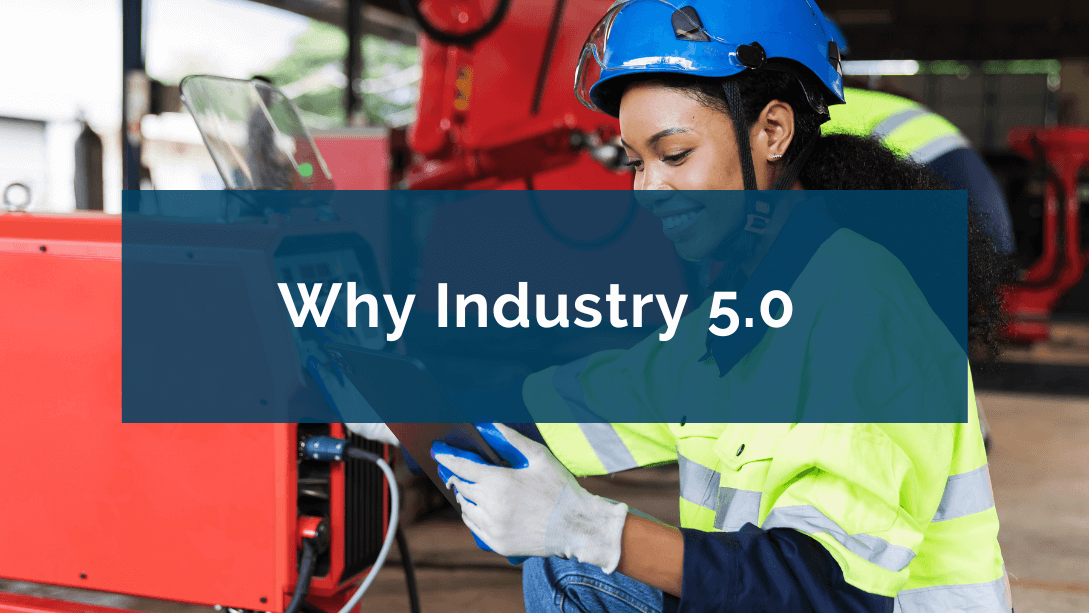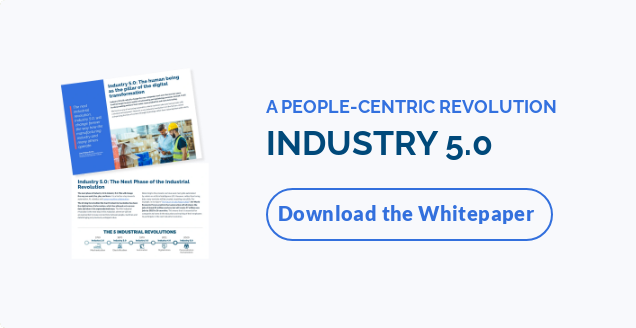A brief overview of Industry 5.0
Industry 5.0 transcends the traditional boundaries between man and machine, creating an environment where human skills and the capabilities of advanced technologies are brought together to form a driving force.
It is based on 3 basic principles:
- People-centricity
- Resilience
- Sustainability
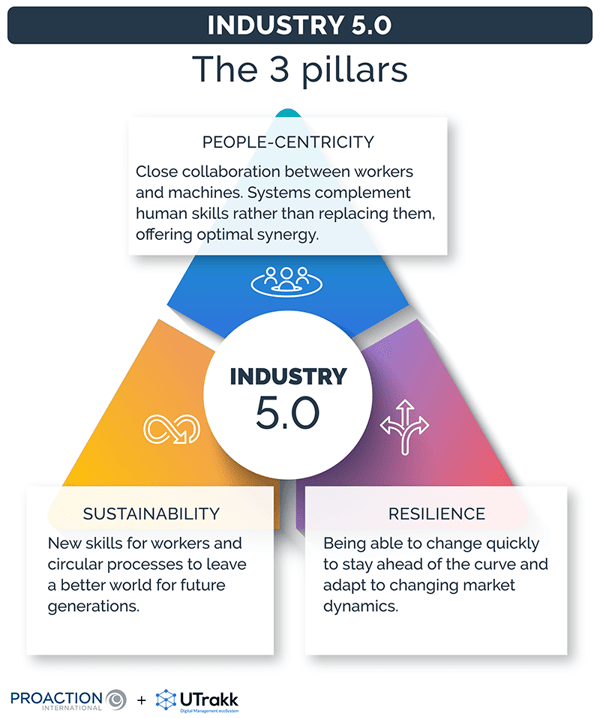
Industry 5.0 goes beyond simply connecting devices; it redefines how we think about production and innovation. Combining the strengths of technology and automation with human workers' unique skills brings to life intelligent collaboration, with machines performing repetitive tasks and individuals contributing on other levels (creativity, critical thinking, decision-making, adaptability, etc.). The result? Unrivalled flexibility and agility in production and optimum performance.
Why should companies adopt Industry 5.0?
As a company, it's in your best interest to adopt Industry 5.0 for several reasons:
Better human-machine collaboration
Prioritizing collaboration between workers and machines allows us to get the best out of each other. This synergy leads not only to innovative problem-solving but also to greater efficiency in operational processes.
Improved productivity
The seamless integration of cutting-edge technologies, such as AI, IoT, and robotics, propels automation to new levels. This intelligent automation frees human workers from routine tasks, enabling greater concentration on high-value-added activities and higher overall productivity.
It is about mobilizing collective intelligence, not least by considering workers' experience as an asset and a source of innovation.
European Commission, Industry 5.0 roundtable
Improved quality and customization
Combining cutting-edge technologies with workers involved in decision-making and problem-solving results in higher-quality products and services. Industry 5.0 also influences personalization. It enables companies to better respond to the varied needs of customers and offer tailor-made solutions.
Agile and flexible operations
The decentralization and interoperability of Industry 5.0 create an environment in which organizations can rapidly adapt to market changes, customer preferences, and production requirements. In short, greater operational agility and enhanced competitiveness!
Optimized supply chain management
Improved connectivity and real-time data exchange throughout the supply chain provide greater visibility and control.
The result: optimized inventory management, reduced lead times, and improved overall supply chain efficiency.
Cost reduction
Automation, predictive maintenance, and efficient resource use all help reduce costs. Indeed, Industry 5.0 helps to minimize expenses, energy consumption, and waste, thus increasing business profitability.
Empowered workforce
Industry 5.0 transforms employees into critical contributors to decision-making processes by focusing on skills enhancement and empowerment.
Collaboration with machines stimulates creativity and problem-solving and increases job satisfaction, resulting in a more motivated and competent workforce.
Innovative product development
This man-machine alliance also helps to shape a culture of innovation. Companies can leverage cutting-edge technologies to streamline product development, bringing new and improved products to market faster.
Improved customer experience
The ability to offer customized products and services, combined with effective supply chain management, enhances the customer experience, boosting satisfaction and loyalty.
Sustainable practices
By optimizing resource management, reducing waste, and optimizing energy consumption, Industry 5.0 aligns with sustainable development goals. Companies can meet the growing demand for environmentally and socially responsible practices, enhancing their reputation and attractiveness in the marketplace.
The challenges of adopting Industry 5.0 (and solutions)
Adopting Industry 5.0 offers considerable benefits, but it has challenges. In particular, here are two significant challenges:
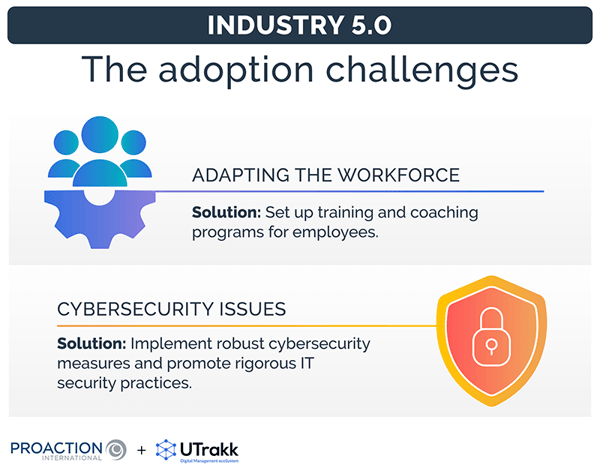
1. Adapting the workforce
Introducing advanced technologies can raise concerns among workers about job security and adapting to new working methods.
Solution: Set up training and coaching programs for employees. These programs should cover issues such as using new technologies, developing complementary skills to machines (notably soft skills), and including vocational retraining components.
The active involvement of workers in the transition process can reduce resistance to change and encourage continuous learning.
2. Cybersecurity issues
The growing interconnectivity between devices and the massive data collection increases the risk of cyber-attacks, threatening information confidentiality and operations stability.
Solution: Implement robust cybersecurity measures by integrating data protection protocols advanced firewalls, and promoting rigorous IT security practices.
Raising employee awareness of cybersecurity and regular security audits will strengthen the company's resilience in the face of potential threats.
8 steps to implement Industry 5.0 in your company
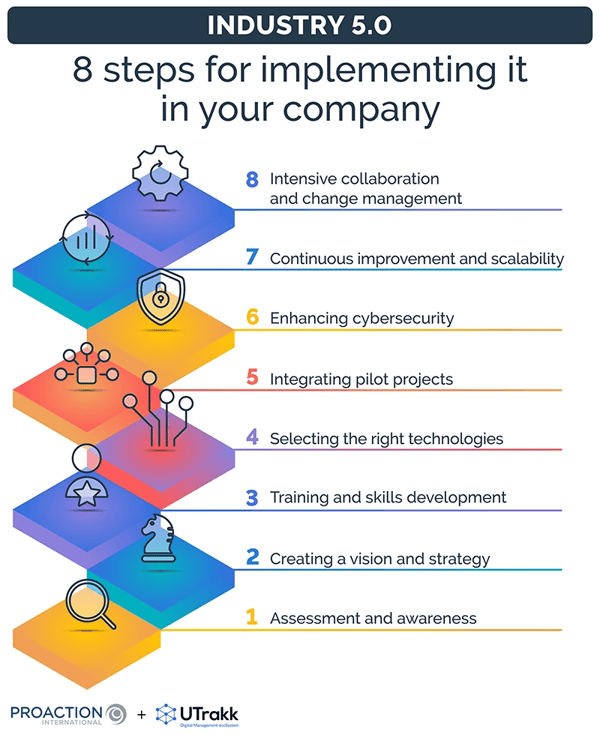
Step 1: Assessment and awareness
The first thing to do is to define your organization's specific needs.
Assess its current technological and operational maturity, identify opportunities and challenges, and make stakeholders aware of the strategic importance of this transition.
Step 2: Creating a vision and strategy
You need to define a clear vision of how Industry 5.0 will transform your business. Draw up a strategy aligned with your business objectives, and identify priority areas for implementation.
Step 3: Training and skills development
Now is the time to invest in coaching and training programs to prepare your workforce for Industry 5.0. Ensure your employees understand the new technologies and develop the skills they need to collaborate with the machines best.
Here, the help of Proaction International's expert coaches can be a significant asset, whether in terms of leadership development, operational excellence, or management digitalization.
Step 4: Selecting the right technologies
Which specific Industry 5.0 technologies best match your needs? It could include AI, collaborative robotics, augmented reality, etc. Select compatible, scalable solutions.
Step 5: Integrating pilot projects
Start by launching pilot projects in specific areas of your business. It will enable you to test technologies, see necessary adjustments, and minimize operational disruption.
Step 6: Enhancing cybersecurity
Consider installing robust cybersecurity protocols to protect sensitive data. Implement advanced firewalls, intrusion detection systems, and educate your employees on security best practices.
Step 7: Continuous improvement and scalability
Industry 5.0 is an evolutionary process. Each of your steps can change and improve with feedback and technological advances. We strongly advise you to plan for scalability in anticipation of future growth.
Step 8: Intensive collaboration and change management
Establish and, above all, maintain collaboration between human teams and machines. Manage change proactively by actively involving employees in the process and communicating regularly on the benefits observed.
Industry 5.0 adoption: The best strategy for sustainable growth
One of the great strengths of Industry 5.0 is that it plays on several fronts: human-machine collaboration, skills development, adoption of sustainable practices, a customer-centric approach, supply chain flexibility, innovation, and adaptability. Despite some challenges, it promises excellent economic, technological, social, and environmental results.
Admittedly, we're still in the Industry 4.0 era, but Industry 5.0 is just around the corner, and it will soon become our new reality. So it's better to plan than to react after the fact. For companies, it is therefore imperative to start integrating Industry 5.0, as it not only guarantees effective adaptation to today's challenges but also positions them as pioneers of a new industrial era.
As you will have gathered, Industry 5.0 is not an option but is necessary for organizations seeking sustainable growth and competitive advantage. By adopting it, you are investing in technology and a fundamental change in how you design work, produce, and supply goods and services. It puts you at the forefront of industrial innovation, paving the way for a flourishing future.
By anticipating and acting now, you will lay a solid foundation to build your future success while helping to create a better world.




